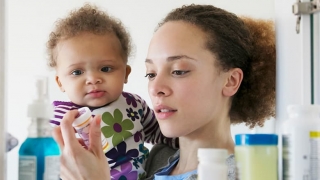What Parents Need to Know about Reading a Medicine Label
Published on
Health Tip of the WeekPublished on
Health Tip of the Week There’s a reason for the label on every medication bottle, box or container you bring home from the pharmacy or grocery store. The information it contains is important: to help your child get well and keep them safe.
There’s a reason for the label on every medication bottle, box or container you bring home from the pharmacy or grocery store. The information it contains is important: to help your child get well and keep them safe.
“The first thing is to always check that you have received your child’s correct medication,” says Marguerite A. Pacholski, BSN, RN, a specialist in poison information in the Poison Control Center at Children’s Hospital of Philadelphia (CHOP). “The label should display your child’s name prominently.”
Next, Pacholski says, is to verify that the package contains the medication your child’s doctor prescribed.
“We all have an overwhelming number of products in our homes that could be harmful if ingested. The adage ‘the dose makes the poison’ is so true,” reminds Pacholski. “Anything can be poisonous if used by the wrong person or taken in the wrong amount.”
Recognizing that label information might be a little tricky to understand, CHOP offers these tips to help make sense of medication labels so you can avoid common – and potentially dangerous – mistakes.
“It’s not only important to be knowledgeable about the label in order to give proper doses or concentrations, but also to find information that may be needed in case of an overdose or accidental ingestion,” says Pacholski. “Concentrations can vary among medications with the same product name. Some may have adult/children/infant formulations that are not interchangeable when it comes to their dosing.”
In terms of medications, parents or caregivers should know how to determine the following:
No matter how careful you are with your family’s medications and over-the-counter medications, accidents do happen. Maybe your baby found a pill on the bathroom floor, or a child ate what they thought were gummy candies. Knowing who to call in that moment is key to the best outcomes.
CHOP’s Poison Control Center provides a 24/7 hotline for possible poison exposures. Registered nurses and pharmacists with special training in toxicology are available to help guide you in these anxious moments after your child swallows or is exposed to a possible dangerous substance. Medications not intended for specific child can be harmful, but by getting professional advice right away, you can ensure your child has the best possible outcome.
The Poison Control Center offers information and treatment advice to the public and healthcare professionals for free through its hotline (1-800-222-1222) and provides downloadable resources on its website at www.chop.edu/poisoncontrol.
“We’re here to help families and we’re only a phone call away,” Pacholski says.
Learn what we need to know to help you when you call the Poison Control Center.
Contributed by: Marguerite A. Pacholski, RN, BSN
Are you looking for advice to keep your child healthy and happy? Do you have questions about common childhood illnesses and injuries? Subscribe to our Health Tips newsletter to receive health and wellness tips from the pediatric experts at Children's Hospital of Philadelphia, straight to your inbox. Read some recent tips.